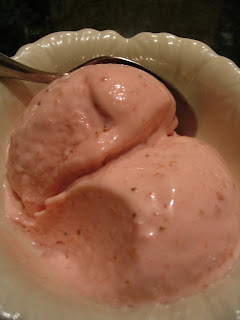 The Per Se event was for chef Thomas Keller's forthcoming book Under Pressure: Cooking Sous Vide. It began with cocktails and hors d'oeuvres at 11am. Just another Wednesday morning for me, you know. Around 11:30 the other journalists and I were ushered into the restaurant's private dining room for a demonstration of the sous-vide technique, in which you submerge food (lamb, watermelon) that has been vacuum-sealed in plastic into a container of water that's been raised to a specific temperature, using an "immersion circulator." What can sous vide do for you? It gives the "perfect" medium-rare in a squab breast. The same temperature throughout an entire cut of meat, not just at the center. A voluptuous texture in salmon. Potatoes cooked perfectly, without their exterior overcooking. And so on. For a super-high-end kitchen like Per Se's, this is a no-brainer. For a home cook, not so much; the equipment is really only available to professionals right now, although Mr. Keller said Kenmore and Viking are working on building products that will allow home cooks to use sous vide someday. After listening to the dreamy Mr. Keller expound on the virtues of sous vide, we sat down to lunch so we could judge for ourselves. Indeed, the Salad of Compressed Summer Melons was vivid and intense. The Nova Scotia Lobster Roll poached in butter was sublime. We ate, oohed and aahed, and then I had to go. Nobu 57 was calling.
The Per Se event was for chef Thomas Keller's forthcoming book Under Pressure: Cooking Sous Vide. It began with cocktails and hors d'oeuvres at 11am. Just another Wednesday morning for me, you know. Around 11:30 the other journalists and I were ushered into the restaurant's private dining room for a demonstration of the sous-vide technique, in which you submerge food (lamb, watermelon) that has been vacuum-sealed in plastic into a container of water that's been raised to a specific temperature, using an "immersion circulator." What can sous vide do for you? It gives the "perfect" medium-rare in a squab breast. The same temperature throughout an entire cut of meat, not just at the center. A voluptuous texture in salmon. Potatoes cooked perfectly, without their exterior overcooking. And so on. For a super-high-end kitchen like Per Se's, this is a no-brainer. For a home cook, not so much; the equipment is really only available to professionals right now, although Mr. Keller said Kenmore and Viking are working on building products that will allow home cooks to use sous vide someday. After listening to the dreamy Mr. Keller expound on the virtues of sous vide, we sat down to lunch so we could judge for ourselves. Indeed, the Salad of Compressed Summer Melons was vivid and intense. The Nova Scotia Lobster Roll poached in butter was sublime. We ate, oohed and aahed, and then I had to go. Nobu 57 was calling.On my way out of Per Se, a waiter handed me an insulated bag. Inside: a piece of vacuum-sealed lamb; packets of garlic, herbs, salt and sauce; and a recipe. I haven't tried it yet, but I have to say this was the coolest goodie bag from a luncheon I've ever received.
 A 10 minute walk across 57th Street and I was at Nobu, where I bumped into Uncle Carl. He loves the place and eats there regularly. We hugged and I ran upstairs to the private dining room, where another group of journalists was just sitting down to lunch. This event was for Nobu Miami: The Party Cookbook, and apparently everyone had just spent the past hour downing sea urchin mojitos and other strange and potent cocktails. They were pretty tipsy, and when the waiter presented our table with a platter of Branzino with Florida Orange Ponzu, they lunged at it. I managed to snag a piece, and while under ordinary circumstances I'd say this was an absolutely delicious piece of fish, its tempura coating sticking perfectly thanks to its sake base, the meat melting in my mouth... after Per Se it felt a little bit like a let-down. Still, the Flounder Sashimi Salad with Yuzu, Honey and aji Limo Dressing was quite tasty, too, and with Dom Perignon 2000 flowing, could I really complain?
A 10 minute walk across 57th Street and I was at Nobu, where I bumped into Uncle Carl. He loves the place and eats there regularly. We hugged and I ran upstairs to the private dining room, where another group of journalists was just sitting down to lunch. This event was for Nobu Miami: The Party Cookbook, and apparently everyone had just spent the past hour downing sea urchin mojitos and other strange and potent cocktails. They were pretty tipsy, and when the waiter presented our table with a platter of Branzino with Florida Orange Ponzu, they lunged at it. I managed to snag a piece, and while under ordinary circumstances I'd say this was an absolutely delicious piece of fish, its tempura coating sticking perfectly thanks to its sake base, the meat melting in my mouth... after Per Se it felt a little bit like a let-down. Still, the Flounder Sashimi Salad with Yuzu, Honey and aji Limo Dressing was quite tasty, too, and with Dom Perignon 2000 flowing, could I really complain?I crawled into a taxi around 2:30. In the span of three hours I had listened to some of the world's best chefs talk about their craft. I'd eaten their amazing, wonderful food. I shmoozed with the hoi polloi of the food writing world. And it was a total New York experience.--S




